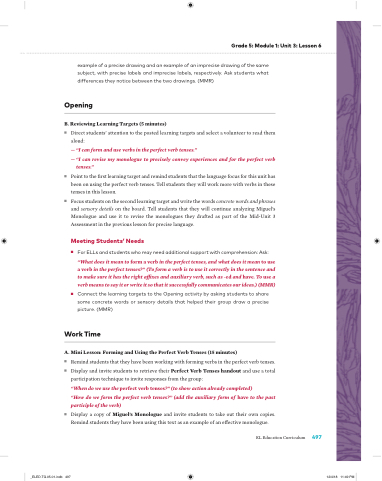Page 521 - EL Grade 5 Teacher Guide
P. 521
Grade 5: Module 1: Unit 3: Lesson 6
example of a precise drawing and an example of an imprecise drawing of the same subject, with precise labels and imprecise labels, respectively. Ask udents what di erences they notice between the two drawings. (MMR)
Opening
B. Reviewing Learning Targets (5 minutes)
■ Direct students’ attention to the posted learning targets and select a volunteer to read them aloud:
— “I can form and use verbs in the perfect verb tenses.”
— “I can revise my monologue to precisely convey experiences and for the perfect verb tenses.”
■ Point to the rst learning target and remind students that the language focus for this unit has been on using the perfect verb tenses. Tell students they will work more with verbs in these tenses in this lesson.
■ Focus students on the second learning target and write the words concrete words and phrases and sensory details on the board. Tell students that they will continue analyzing Miguel’s Monologue and use it to revise the monologues they drafted as part of the Mid-Unit 3 Assessment in the previous lesson for precise language.
Meeting Students’ Needs
■ For ELLs and udents who may need additional support with comprehension: Ask:
“What does it mean to form a verb in the perfect tenses, and what does it mean to use a verb in the perfect tenses?” (To form a verb is to use it correctly in the sentence and to make sure it has the right a xes and auxiliary verb, such as -ed and have. To use a verb means to say it or write it so that it successfully communicates our ideas.) (MMR)
■ Connect the learning targets to the Opening activity by asking udents to share some concrete words or sensory details that helped their group draw a precise picture. (MMR)
Work Time
A. Mini Lesson: Forming and Using the Perfect Verb Tenses (15 minutes)
■ Remind students that they have been working with forming verbs in the perfect verb tenses.
■ Display and invite students to retrieve their Perfect Verb Tenses handout and use a total
participation technique to invite responses from the group:
“When do we use the perfect verb tenses?” (to show action already completed)
“How do we form the perfect verb tenses?” (add the auxiliary form of have to the past
participle of the verb)
■ Display a copy of Miguel’s Monologue and invite students to take out their own copies. Remind students they have been using this text as an example of an e ective monologue.
EL Education Curriculum 497
_ELED.TG.05.01.indb 497
12/4/18 11:49 PM


